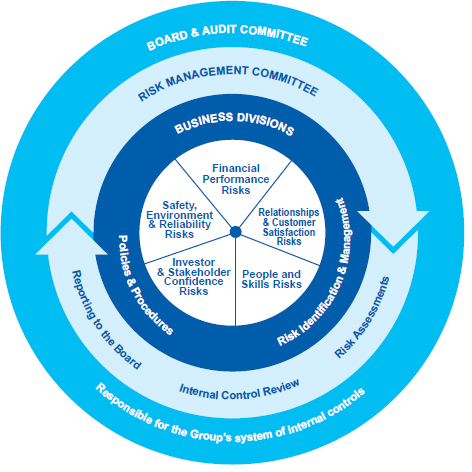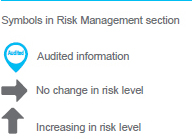
RISK MANAGEMENT
Risk management plays an important and high level role in ensuring we achieve the long-term vision and mission of Pacific Basin, which we believe enhances long-term shareholder value. It is embedded in our business functions and aims to prevent our strategies and objectives from being thrown off course.
We are exposed to a variety of risks, which are summarised in the Group Overview section of this report. The risk management function helps management to track our Group's risks and to formulate appropriate mitigating actions to protect our business, stakeholders, assets and capital.
RISK IDENTIFICATION AND OVERSIGHT STRUCTURE
The Board has overall responsibility for the assessment and management of risks and the Group's system of internal controls. The primary responsibility for risk identification and management lies with the respective business heads.
The Risk Management Committee, reporting to the Audit Committee, is responsible for strengthening the Group's risk management culture, ensuring the overall framework of risk management is comprehensive and responsive to changes in the business, and managing the internal audit function. It regularly reviews the completeness and accuracy of, and follows up on risk assessments, risk reporting and the adequacy of risk mitigation efforts.
Annual assessments are carried out to identify, assess and manage risks.
Identified risks and the corresponding mitigation measures are documented in our risk register.
The Risk Management Committee held four meetings during the year to review the status and findings of the risk management activities, discuss new risks identified and assess their related mitigation measures.

PRINCIPAL RISKS
The Group categorises the diverse range of risks we face under headings driven by our key business driver groups.
| RISKS/IMPACTS | RISK REDUCTION MEASURES | CHANGE FROM LAST YEAR | ||
|---|---|---|---|---|
Market RiskAdverse financial impacts due to:
|
Earnings volatility
Cost volatility
Exchange rate volatility
We also use derivative instruments to manage volatility in dry bulk freight rates, fuel prices, interest rates and exchange rates. |

|
||
Vessel Investment & Deployment RiskInappropriate timing and choices of vessel investment and deployment may lead to an uncompetitive cost structure and reduced margins. The value of our vessels may vary significantly through shipping cycles, and we need competitively priced and high quality vessels to provide our services to customers. |
We evaluate potential investments and divestments based on relevant market information, estimated future earnings and residual values to maximise returns to shareholders. We adopt a flexible ownership/leasing strategy that is aligned with shipping cycles, and we consider maintaining an active fleet renewal programme by:
|

|
||
Credit & Counterparty RiskDefault or failure of counterparties to honour their contractual obligations may cause financial loss. These counterparties include:
|
Our global network of offices positions us close to our counterparties allowing us to better know them, thus minimising the risk of counterparty failure. In addition, we take measures to limit our credit exposure by:
The management of trade receivables and our credit policy are set out in the Financial Statement section. |

Due to increased concentration risk of receivables in relation to the sale of our RoRo vessels. |
||
Insurance RiskAny vessel accident could endanger our crew, adversely affect the strength of our brand and our reputation with stakeholders and result in service disruption and significant costs. |
We implemented measures to ensure safe operations across our companies and fleets which have positively impacted our performance in safety. However, accidents do happen, and so we place insurance cover at competitive rates through marine insurance products, including hull and machinery, war risk, protection and indemnity, freight demurrage and defense cover, etc. Sufficiency of insurance cover is regularly evaluated and adjusted in line with prevailing asset values and in compliance with loan covenants and internal policies. |

|
||
Liquidity RiskInsufficient financial resources (such as bank borrowing facilities) may result in the Group not meeting its payment obligations as they fall due. |
We regularly review our Group's treasury policy to ensure:
|

Due to limited availability of credit lines from the banking industry. |
||
Capital Management RiskWeakness in our financial management capability and insufficient capital could impact our ability to operate as a going concern, provide adequate returns to shareholders, and benefit other stakeholders to support the stability and growth of the Group. |
We conduct regular reviews to ensure an optimal capital structure after considering:
Our dividend policy is to distribute regular dividends to shareholders and to pay out a minimum of 50% of eligible profits for the year, with the remainder of the profits retained as capital for future use. Our Board of Directors monitors closely the ratio of net borrowings to net book value of property, plant and equipment, and the ratio of net borrowings to shareholders' equity. |

|
||
| RISKS/IMPACTS | RISK REDUCTION MEASURES | CHANGE FROM LAST YEAR | ||
|---|---|---|---|---|
Customer Satisfaction & Reputation RiskPoor service could lead to loss of customers. Adverse impacts to our brand value and reputation as a trusted counterparty may restrict our access to customers, cargoes, high quality vessels, funding and talent. |
Our global office network position us closer to our customers enabling a clear understanding of their needs and first-rate, localised customer service. A large, modern, uniform fleet and a comprehensive in-house technical operations function enhance our ability to deliver a high-quality and reliable service. Frequent customer engagement enhances customer satisfaction. |

|
||
Banking Relationships RiskPoor relationships with banks may reduce our ability to access different funding sources. |
We have a dedicated treasury function tasked with developing and maintaining relationships with a diverse group of reputable banks worldwide. These relationships are maintained and augmented through regular senior management contact and consistent compliance with our loan obligations. |

|
||
| RISKS/IMPACTS | RISK REDUCTION MEASURES | CHANGE FROM LAST YEAR | ||
|---|---|---|---|---|
Employee Engagement RiskWe are only as good as our people and so our ability to move towards our vision depends on the effectiveness of our staff both ashore and at sea. Loss of key staff or an inability to attract, train or retain staff could affect our ability to achieve our long-term goals and expand our business. |
Group HR and Crewing departments are tasked with recruiting and maximising engagement of staff ashore and at sea.
|

|
||
Succession RiskInadequate succession planning could lead to prolonged executive searches, disruption to our strategic momentum and the business, and undermine stakeholder confidence in the Group. |
The Group has a dedicated HR department which oversees organisational design, talent management, hiring and remuneration. Succession plans for senior management are regularly reviewed. The Group closely monitors the Board succession planning process through its Nomination Committee so as to ensure Board continuity. The Group has a clear vision, mission and business principles to ensure that any potential successors are equipped to lead the business forward. |
Emerging risk as the organisation grows. |
||
| RISKS/IMPACTS | RISK REDUCTION MEASURES | CHANGE FROM LAST YEAR | ||
|---|---|---|---|---|
Corporate Governance RiskInadequate corporate governance measures may adversely impact the diligence, integrity and transparency of our risk assessment, decision-making and reporting processes and undermine stakeholder confidence. |
The Group has a committed structure on Corporate Governance to meet the needs and requirements of the business and its stakeholders. The Audit Committee and the Risk Management Committee are proactively ensuring the overall corporate governance and risk management framework for the Group. During the year, the Board and relevant employees received regular trainings in relation to corporate governance matters to ensure high standard of corporate governance. |

|
||
Investor Relations RiskAn ineffective investor relations function or inadequate transparency in our external communications could undermine stakeholder confidence in our Group. |
The Group has a dedicated investor relations function as well as policies and guidelines on communication and disclosure of information to the public. Our website is updated regularly with company news and financial information. |

|
||
| RISKS/IMPACTS | RISK REDUCTION MEASURES | CHANGE FROM LAST YEAR | ||
|---|---|---|---|---|
Safety RiskPiracy, inadequate safety and operational standards and other causes of accidents may lead to loss of life, severe damage to property and our vessels, and impact the Group's reputation among seafarers, customers and other stakeholders. |
Our commitment to the safe operation of our ships is manifested through a proactive system ashore and at sea – the Pacific Basin Management System – enhanced by well-conceived training and maintenance programmes and innovative initiatives to ensure our vessels are in good condition and in all respects safe to trade. The high quality of our attention to safety is evidenced by an excellent safety record and our several safety-related awards in recent years. |

|
||
Environmental RiskNon-compliance with environmental emissions and standards may result in financial loss and significant damage to our brand and the long-term sustainability of our business. |
Emissions reductionWe are at the forefront of efforts in our sector to reduce emissions. Such emissions reduction efforts include initiatives to improve engine performance and hull and propulsion hydrodynamics, and to adopt fuel-efficient operational measures. Pollution liabilityWe promote a proactive safety culture across our fleet involving safety risk assessments to mitigate risk in critical tasks on board. Through our safety training, we seek to eradicate the risk of accidents that lead to pollution and related penalties, costs and adverse publicity. In addition, we cover our risk of liability for pollution through membership of reputed Protection & Indemnity (P&I) clubs. |

|
||
Vessels & Systems RiskThe strength of our operational performance depends on the effective deployment of our vessels and the reliability of our systems and technology. Failure to operate and utilise reliable vessels, equipment and systems could result in vessel down-time, service disruption and disruption to communications. |
Vessels operational riskWe operate high-quality vessels built by reputable shipyards which we maintain to a high standard under our ISM Code compliant "Pacific Basin Management System" to assure safety and reliability of service. Systems riskRegular meetings of our IT Governance Committee to oversee the Group's IT policies and procedures ensure that our IT strategies are met. Preventive or contingency measures are in place to minimise the risk of system failures and to promptly address system breakdowns. Our IT team receives regular technical training and our general staff are regularly updated of IT policies and system upgrades. |

|
||




